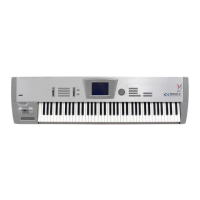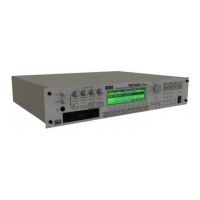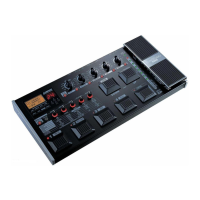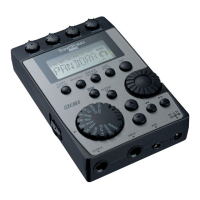Do you have a question about the Korg T2 and is the answer not in the manual?
Essential safety precautions and warnings for operating the product.
Instruction to retain safety guidelines for future reference.
Avoiding adverse conditions, handling gently, and managing interference.
Requirements for correct power supply and cleaning the unit.
Floppy drive precautions, manual reference, and backup battery info.
Important warnings related to disk operations and data.
Mode select, Bank/Page, Cursor, Display navigation controls.
Value slider, Number keys, and Edit Function keys.
REC and START/STOP keys for recording and playback.
Slots for PCM and PROG/SEQ data cards.
MIDI IN/OUT/THRU, Phones, and Audio Output connections.
LCD Contrast, Damper, and Pedal/Footswitch connections.
Step-by-step guide for connecting the instrument to other gear.
Technical information on the playable note range for each model.
Procedure for selecting and playing combined sounds.
Procedure for selecting and playing individual sounds.
Instructions on how to play the built-in demonstration songs.
Mode keys, Bank/Page, Cursor, and Display navigation controls.
Number keys, Edit Function keys, and FINE key for adjustments.
FINE, MARK, JUMP, MENU, COMPARE, WRITE key functions.
CURSOR POSITION and UP/DOWN keys for parameter selection.
VALUE slider and Delta (△/▽) keys for parameter modification.
PAGE+/-, START/STOP, and REC keys for operation.
Structure of Program/Sequence and PCM disk formats.
Information on using M1/M1R compatible data cards.
Identifying drive parts, insertion procedure, and precautions.
Safe removal of disks and cleaning the drive heads.
Description of disk parts, handling, and environmental factors.
Explanation of the write protect tab for data safety.
Recommendation for creating backup copies of important data.
Steps and requirements for formatting new floppy disks.
Managing program changes for timbres versus combinations.
Examples: Layering, Independent Sources, MIDI Overflow.
Examples of connecting T1/T2/T3 with other instruments.
Using an external sequencer to control the T1/T2/T3.
How combinations utilize programs and effects.
Breakdown of Timbres, Programs, and Oscillators.
Selecting the Multisound (Oscillator) for a new sound.
Processing the Multisound using VDF and VDA parameters.
Setting effect parameters and their placement.
Assigning drum sounds and storing Drum Kits.
What a Program is and how it's stored.
Combining multiple Programs for layers, splits, or velocity switching.
Assigning sounds to outputs and effects.
Saving factory settings and initializing disks for use.
Steps for saving current data to a disk.
Explains the OSC, VDF, VDA, EG, MG blocks in a Program.
How to access and select programs for modification.
Setting Oscillator Mode (SINGLE/DOUBLE/DRUM) and Polyphony.
Adjusting Multisound, Level, and Assign parameters.
Adjusting Attack, Decay, Release times and levels.
Adjusting tone brightness and keyboard response.
Adjusting tone envelope time and breakpoint levels.
Adjusting tone envelope slope time and sustain level.
Adjusting volume response to velocity and keyboard position.
Adjusting volume envelope time and breakpoint levels.
Adjusting volume envelope slope time and sustain level.
Configuring the second oscillator in DOUBLE mode.
Setting pitch bend range and joystick modulation.
Adjusting aftertouch for pitch, tone, and volume.
Configuring vibrato effects using Pitch MG.
Configuring tone modulation effects using VDF MG.
Introduction to the instrument's available built-in effects.
Understanding Serial vs. Parallel effect routing.
Adjusting reverb characteristics like time and pre-delay.
Adjusting early reflection characteristics.
Adjusting delay time, feedback, and stereo delay.
Adjusting chorus modulation for spaciousness and depth.
Adjusting flanger and phase shifter modulation.
Adjusting EQ and adding overdrive/distortion.
Enhancing sound brilliance and richness.
Simulating rotary speaker sounds for organs/pianos.
Applying different effects to outputs A, B, C, D.
Saving the edited combination and assigning a name.
Transferring effect parameters from other sources.
Assigning MIDI CCs to foot controllers and joysticks.
Adjusting scale types and temperaments.
Adjusting response sensitivity to velocity and aftertouch.
Copying settings between oscillators.
Layering, splitting, and velocity switching with multiple Programs.
Selecting sounds for each Timbre within a Combination.
Adjusting the volume for each Timbre in a Combination.
Setting how keyboard velocity affects Timbre volume/tone.
Combination velocity curves override individual Program settings.
Setting how aftertouch affects Timbre pitch/tone.
Adjusting the pitch of each Timbre.
Routing Timbre output to effects and stereo channels.
Setting MIDI channels for controlling external devices.
Defining the velocity range for each Timbre.
Defining the key range for each Timbre.
How velocity window top/bottom values interact.
How key window top/bottom values interact.
Controlling reception of program change messages per Timbre.
Controlling reception of controller messages per Timbre.
Controlling damper pedal effect per Timbre.
Controlling aftertouch effect per Timbre.
Assigning MIDI CCs to foot controllers and joysticks.
Transmitting program numbers to external MIDI devices.
Applying global temperaments to all Timbres.
Setting velocity response for external MIDI devices.
Setting aftertouch response for external MIDI devices.
Setting and copying effect parameters for a combination.
Saving the edited combination and assigning a custom name.
Preventing accidental overwrites of combination data.
Overview of the steps involved in creating a song.
Detailed steps for recording tracks in realtime.
Transcribing musical notation into tracks.
Procedures for managing recorded song data.
Steps for creating drum patterns using recording methods.
Setting tempo, resolution, and metronome for patterns.
Diagram showing drum sounds assigned to keyboard keys.
Correcting notes during recording using ADD/RMV or ERA keys.
Using Put Pattern and Copy From Pattern functions.
Inserting, deleting, erasing, and quantizing track/measure data.
Correcting the timing of recorded notes.
Comparison of Put Pattern and Copy From Pattern methods.
Recording the bass part in realtime.
Re-recording specific measures within a track.
Refining timing correction with quantization.
Recording the melody track in realtime.
Using event editing to insert program changes into a track.
Recording guitar, strings, and flute parts.
Fine-tuning the volume levels of individual tracks.
Detailed procedure for step recording complex phrases.
Demonstration of step recording a pattern.
Inputting notes, chords, and timing using step recording.
Setting final track volumes and pan positions.
Preparing disks for saving data by formatting them.
Storing project data, including songs and effects, to disk.
Retrieving previously saved project data from a disk.
Summary of functions for editing entire tracks or specific measures.
Summary of functions for editing patterns.
How patterns and tracks are linked via Put/Copy operations.
Selecting songs, tracks, and managing parameters.
Setting pattern parameters and using recording methods.
Visual guide to accessing various editing functions.
Details regarding the product's manufacturer warranty.
Essential safety precautions and warnings for operating the product.
Instruction to retain safety guidelines for future reference.
Avoiding adverse conditions, handling gently, and managing interference.
Requirements for correct power supply and cleaning the unit.
Floppy drive precautions, manual reference, and backup battery info.
Important warnings related to disk operations and data.
Mode select, Bank/Page, Cursor, Display navigation controls.
Value slider, Number keys, and Edit Function keys.
REC and START/STOP keys for recording and playback.
Slots for PCM and PROG/SEQ data cards.
MIDI IN/OUT/THRU, Phones, and Audio Output connections.
LCD Contrast, Damper, and Pedal/Footswitch connections.
Step-by-step guide for connecting the instrument to other gear.
Technical information on the playable note range for each model.
Procedure for selecting and playing combined sounds.
Procedure for selecting and playing individual sounds.
Instructions on how to play the built-in demonstration songs.
Mode keys, Bank/Page, Cursor, and Display navigation controls.
Number keys, Edit Function keys, and FINE key for adjustments.
FINE, MARK, JUMP, MENU, COMPARE, WRITE key functions.
CURSOR POSITION and UP/DOWN keys for parameter selection.
VALUE slider and Delta (△/▽) keys for parameter modification.
PAGE+/-, START/STOP, and REC keys for operation.
Structure of Program/Sequence and PCM disk formats.
Information on using M1/M1R compatible data cards.
Identifying drive parts, insertion procedure, and precautions.
Safe removal of disks and cleaning the drive heads.
Description of disk parts, handling, and environmental factors.
Explanation of the write protect tab for data safety.
Recommendation for creating backup copies of important data.
Steps and requirements for formatting new floppy disks.
Managing program changes for timbres versus combinations.
Examples: Layering, Independent Sources, MIDI Overflow.
Examples of connecting T1/T2/T3 with other instruments.
Using an external sequencer to control the T1/T2/T3.
How combinations utilize programs and effects.
Breakdown of Timbres, Programs, and Oscillators.
Selecting the Multisound (Oscillator) for a new sound.
Processing the Multisound using VDF and VDA parameters.
Setting effect parameters and their placement.
Assigning drum sounds and storing Drum Kits.
What a Program is and how it's stored.
Combining multiple Programs for layers, splits, or velocity switching.
Assigning sounds to outputs and effects.
Saving factory settings and initializing disks for use.
Steps for saving current data to a disk.
Explains the OSC, VDF, VDA, EG, MG blocks in a Program.
How to access and select programs for modification.
Setting Oscillator Mode (SINGLE/DOUBLE/DRUM) and Polyphony.
Adjusting Multisound, Level, and Assign parameters.
Adjusting Attack, Decay, Release times and levels.
Adjusting tone brightness and keyboard response.
Adjusting tone envelope time and breakpoint levels.
Adjusting tone envelope slope time and sustain level.
Adjusting volume response to velocity and keyboard position.
Adjusting volume envelope time and breakpoint levels.
Adjusting volume envelope slope time and sustain level.
Configuring the second oscillator in DOUBLE mode.
Setting pitch bend range and joystick modulation.
Adjusting aftertouch for pitch, tone, and volume.
Configuring vibrato effects using Pitch MG.
Configuring tone modulation effects using VDF MG.
Introduction to the instrument's available built-in effects.
Understanding Serial vs. Parallel effect routing.
Adjusting reverb characteristics like time and pre-delay.
Adjusting early reflection characteristics.
Adjusting delay time, feedback, and stereo delay.
Adjusting chorus modulation for spaciousness and depth.
Adjusting flanger and phase shifter modulation.
Adjusting EQ and adding overdrive/distortion.
Enhancing sound brilliance and richness.
Simulating rotary speaker sounds for organs/pianos.
Applying different effects to outputs A, B, C, D.
Saving the edited combination and assigning a name.
Transferring effect parameters from other sources.
Assigning MIDI CCs to foot controllers and joysticks.
Adjusting scale types and temperaments.
Adjusting response sensitivity to velocity and aftertouch.
Copying settings between oscillators.
Layering, splitting, and velocity switching with multiple Programs.
Selecting sounds for each Timbre within a Combination.
Adjusting the volume for each Timbre in a Combination.
Setting how keyboard velocity affects Timbre volume/tone.
Combination velocity curves override individual Program settings.
Setting how aftertouch affects Timbre pitch/tone.
Adjusting the pitch of each Timbre.
Routing Timbre output to effects and stereo channels.
Setting MIDI channels for controlling external devices.
Defining the velocity range for each Timbre.
Defining the key range for each Timbre.
How velocity window top/bottom values interact.
How key window top/bottom values interact.
Controlling reception of program change messages per Timbre.
Controlling reception of controller messages per Timbre.
Controlling damper pedal effect per Timbre.
Controlling aftertouch effect per Timbre.
Assigning MIDI CCs to foot controllers and joysticks.
Transmitting program numbers to external MIDI devices.
Applying global temperaments to all Timbres.
Setting velocity response for external MIDI devices.
Setting aftertouch response for external MIDI devices.
Setting and copying effect parameters for a combination.
Saving the edited combination and assigning a custom name.
Preventing accidental overwrites of combination data.
Overview of the steps involved in creating a song.
Detailed steps for recording tracks in realtime.
Transcribing musical notation into tracks.
Procedures for managing recorded song data.
Steps for creating drum patterns using recording methods.
Setting tempo, resolution, and metronome for patterns.
Diagram showing drum sounds assigned to keyboard keys.
Correcting notes during recording using ADD/RMV or ERA keys.
Using Put Pattern and Copy From Pattern functions.
Inserting, deleting, erasing, and quantizing track/measure data.
Correcting the timing of recorded notes.
Comparison of Put Pattern and Copy From Pattern methods.
Recording the bass part in realtime.
Re-recording specific measures within a track.
Refining timing correction with quantization.
Recording the melody track in realtime.
Using event editing to insert program changes into a track.
Recording guitar, strings, and flute parts.
Fine-tuning the volume levels of individual tracks.
Detailed procedure for step recording complex phrases.
Demonstration of step recording a pattern.
Inputting notes, chords, and timing using step recording.
Setting final track volumes and pan positions.
Preparing disks for saving data by formatting them.
Storing project data, including songs and effects, to disk.
Retrieving previously saved project data from a disk.
Summary of functions for editing entire tracks or specific measures.
Summary of functions for editing patterns.
How patterns and tracks are linked via Put/Copy operations.
Selecting songs, tracks, and managing parameters.
Setting pattern parameters and using recording methods.
Visual guide to accessing various editing functions.
Details regarding the product's manufacturer warranty.
| Multitimbral | 8 parts |
|---|---|
| Display | LCD |
| MIDI | In/Out/Thru |
| Synthesis Type | AI Synthesis (Advanced Integrated) |
| ROM | 8 MB |
| Keyboard | 61 keys |
| Sequencer | 16-track sequencer |
| Outputs | Stereo (L/Mono, R), Headphones |
| Storage | 3.5" Floppy Disk Drive |











